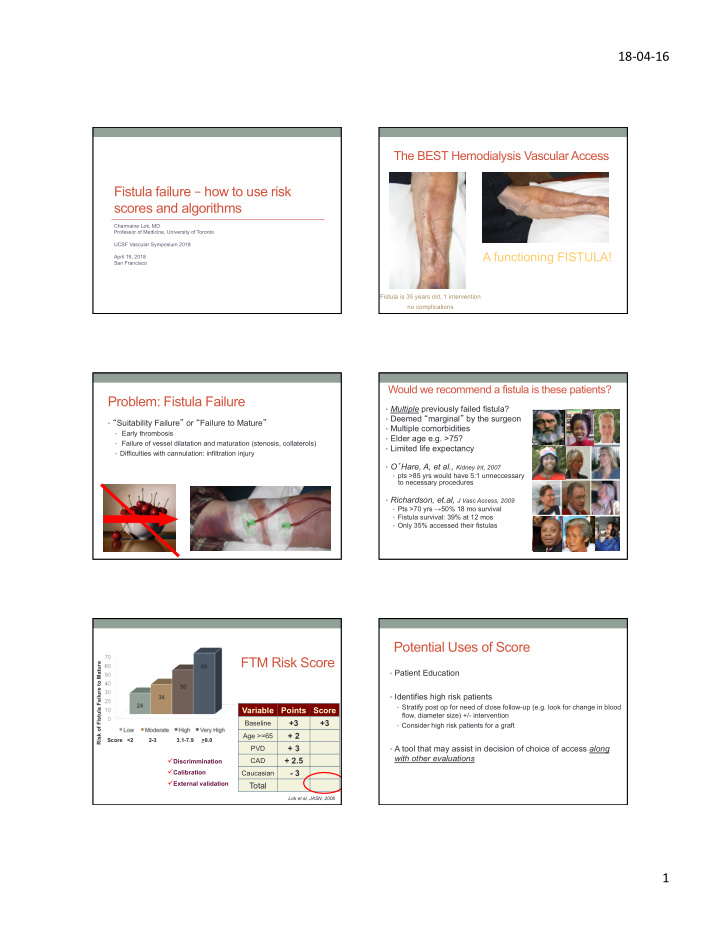



18-04-16 The BEST Hemodialysis Vascular Access Fistula failure – how to use risk scores and algorithms Charmaine Lok, MD Professor of Medicine, University of Toronto UCSF Vascular Symposium 2018 A functioning FISTULA! April 19, 2018 San Francisco Fistula is 35 years old, 1 intervention no complications Would we recommend a fistula is these patients? Problem: Fistula Failure • Multiple previously failed fistula? • Deemed “ marginal ” by the surgeon • “ Suitability Failure ” or “ Failure to Mature ” • Multiple comorbidities • Early thrombosis • Elder age e.g. >75? • Failure of vessel dilatation and maturation (stenosis, collaterols) • Limited life expectancy • Difficulties with cannulation: infiltration injury • O ’ Hare, A, et al., Kidney Int, 2007 • pts >85 yrs would have 5:1 unneccessary to necessary procedures • Richardson, et.al, J Vasc Access, 2009 • Pts >70 yrs → 50% 18 mo survival • Fistula survival: 39% at 12 mos • Only 35% accessed their fistulas Potential Uses of Score FTM Risk Score Risk of Fistula Failure to Mature • Patient Education • Identifies high risk patients • Stratify post op for need of close follow-up (e.g. look for change in blood Variable Points Score flow, diameter size) +/- intervention +3 +3 Baseline • Consider high risk patients for a graft + 2 Age >=65 Score <2 2-3 3.1-7.9 >8.0 PVD + 3 • A tool that may assist in decision of choice of access along with other evaluations + 2.5 ü CAD Discrimmination ü Calibration Caucasian - 3 ü External validation Total Lok et al, JASN, 2006 1
18-04-16 Great! What are “other” evaluations? HOW WELL DO SURGEONS PREDICT? This Patient Comes to See You Application to Our Patient Score for Our • 68 years old, active Variable Points Patient • Non-caucasian • Longstanding HTN +3 Baseline +3 • DM II, poorly controlled; Age >=65 + 2 +2 had BKA • Already has 2 failed PVD + 3 +3 forearm fistulas, eGFR 15 ml/min , ACR 3 mg/mmol CAD + 2.5 0 • Patient strongly dislike needles, Caucasian - 3 0 “ okay ” with continual CVC use • PD not an option Total 8 = Very High Risk Nb: High risk if Caucasian (score=5) Implementation Considerations Tangri KFRE and our case Critical Data to Consider for Access Creation • Patient ’ s CKD status + timelines • Predialysis or long-term dialysis? • Timeframe for fistula creation and maturation • Patient ’ s overall status • Patient survival should be at least equivalent to access survival • Risk of fistula failure → should consider: • History of prior access failure • Vessel quality as per surgeon evaluation +/- vessel mapping • Clinical factors (+/- with help of Score ) 2
18-04-16 KFRE Results Clinical Thinking & Risk Stratification Results Allon & Lok, CJASN, 2010 The Graft A Patient ’ s Access Trajectory … .. can harmoniously include Grafts and Fistulae Don’t Forget about Secondary AVF 3
18-04-16 Practical Considerations for Graft Points about Prediction Models • Prevalent dialysis patients FTM Risk Score Stenosis Size • Suffered multiple prior fistula failures • Needs an UPDATE! Calcification Vessel • Patients and • Has high – very high FTM risk score integrity practice patterns Flow Venipuncture/ PICCs etc have changed • Incident patients • Generalizability to Mobility Nutrition CVD CHF • Expected to start HD in 2-3 weeks + high –very high FTM YOUR patient population risk score - ↑ likelihood CVC Functional AGE Comorbidity status • In such cases, emphasis= temporary in preparation for Tangri KFRE DM CAD secondary AVF fistula once graft becomes problematic Cognition PVD • Has not been tested/ • Advantages: start HD without CVC & avoid complications; validated for clinical use Available for VA planning access Sites improve bloodflow and vessel calibre for fistula Interventions • ? Pts who went on for Impact of Highlights need for timely and appropriate vascular access prior access VA surgery vs not • Competing risk of death care Surgeon Reasons for Factors loss Summary: Use of Risk Scores & Algorithms THANK YOU! § Fistulas continue to have high rates of FTM /non- suitability for dialysis § Risk scores are tools that may support a clinician/surgeon’s decision making § Multiple variables must be considered in deciding on hemodialysis AVF creation – patient age, comorbidity, vessel characteristics, timing +more § Tangri KFRE may be used in help priorize urgency for decision making and planning for AVF creation and use § FTM Score is one tool that may assist in determining risk of fistula failure § Fistulas remain the preferred vascular access for dialysis if they mature and are usable § Grafts are a reasonable alternative and better than a catheter whenever a fistula is not feasible or appropriate 4
Recommend
More recommend